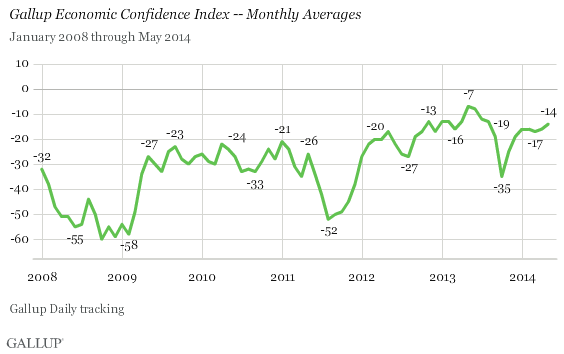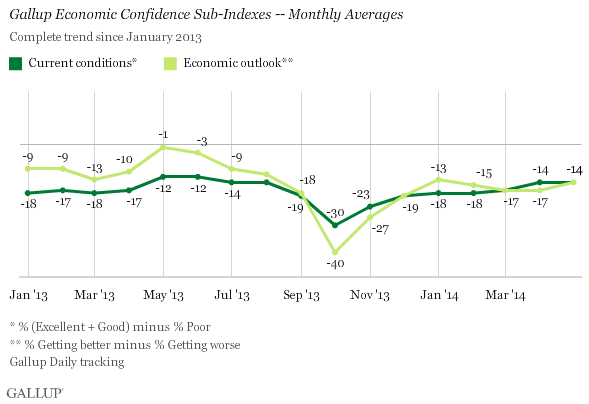WASHINGTON, D.C. -- Gallup's U.S. Economic Confidence Index increased to -14 in May, its highest monthly reading in 2014 so far. May's economic confidence reading, however, remains significantly below the -7 average found in May 2013, which was the highest monthly average since Gallup began tracking the measure in 2008.

The improved Economic Confidence Index score for May includes a -13 economic confidence reading for the week of May 26-June 1, which was the highest weekly reading since early January of this year.
In recent years, May has generally been an eventful month for economic confidence, sometimes seeing substantial gains from April. In May 2011, the index climbed 10 points as part of a broader increase in Americans' optimism after the death of Osama bin Laden. And May 2013 holds the record for the highest monthly economic confidence score since Gallup Daily tracking began in 2008. A seasonal boost in May isn't always the norm, however, as confidence dropped slightly in May 2010 and was flat in May 2008.
Gallup's Economic Confidence Index is an average of two components: Americans' views of the current economic situation and their perceptions of whether the economy is getting better or worse. In last month's average, views of the current economic situation remained the same as in April, with 20% rating the economy as "excellent" or "good," while 34% say it is "poor," resulting in a current conditions score of -14. Meanwhile, Americans' views about the direction of the economy improved with 40% saying the economy is "getting better," and 54% saying it is "getting worse." This results in an economic outlook score of -14, up from April's score of -17.

Bottom Line
All in all, May's two-point gain in Gallup's economic confidence reading lends credence to the idea that confidence is stable and gradually improving. However, given the propensity of economic confidence since the Great Recession to fall whenever it approaches the neutral mark, any improvement -- or even stability -- is positive.
The uptick in confidence comes in conjunction with a six-year high in consumer spending, and a promising Job Creation Index reading for April. Though economic confidence remains in negative territory, these other encouraging factors in the U.S. economy suggest that confidence may continue to edge higher.
Survey Methods
Results for this Gallup poll are based on telephone interviews conducted May 1-31, 2014, on the Gallup Daily tracking survey, with a random sample of 15,726 adults, aged 18 and older, living in all 50 U.S. states and the District of Columbia.
For results based on the total sample of national adults, the margin of sampling error is ±1 percentage point at the 95% confidence level.
Interviews are conducted with respondents on landline telephones and cellular phones, with interviews conducted in Spanish for respondents who are primarily Spanish-speaking. Each sample of national adults includes a minimum quota of 50% cellphone respondents and 50% landline respondents, with additional minimum quotas by time zone within region. Landline and cellular telephone numbers are selected using random-digit-dial methods. Landline respondents are chosen at random within each household on the basis of which member had the most recent birthday.
Samples are weighted to correct for unequal selection probability, nonresponse, and double coverage of landline and cell users in the two sampling frames. They are also weighted to match the national demographics of gender, age, race, Hispanic ethnicity, education, region, population density, and phone status (cellphone only/landline only/both, and cellphone mostly). Demographic weighting targets are based on the most recent Current Population Survey figures for the aged 18 and older U.S. population. Phone status targets are based on the most recent National Health Interview Survey. Population density targets are based on the most recent U.S. census. All reported margins of sampling error include the computed design effects for weighting.
In addition to sampling error, question wording and practical difficulties in conducting surveys can introduce error or bias into the findings of public opinion polls.
For more details on Gallup's polling methodology, visit www.gallup.com.
